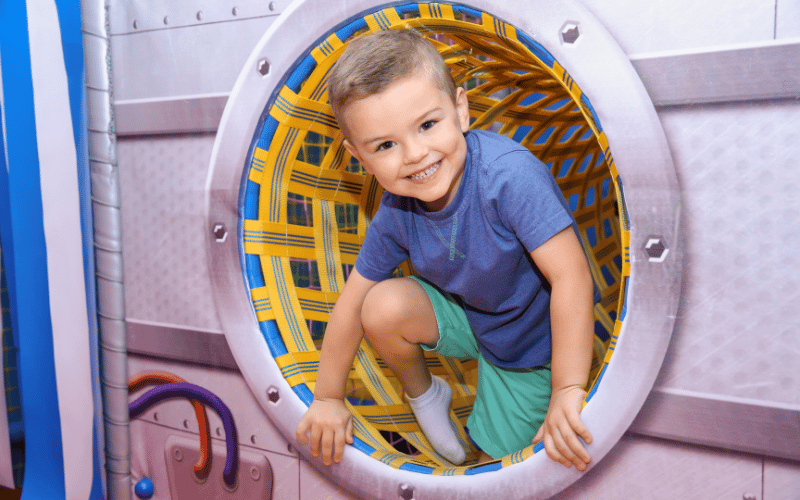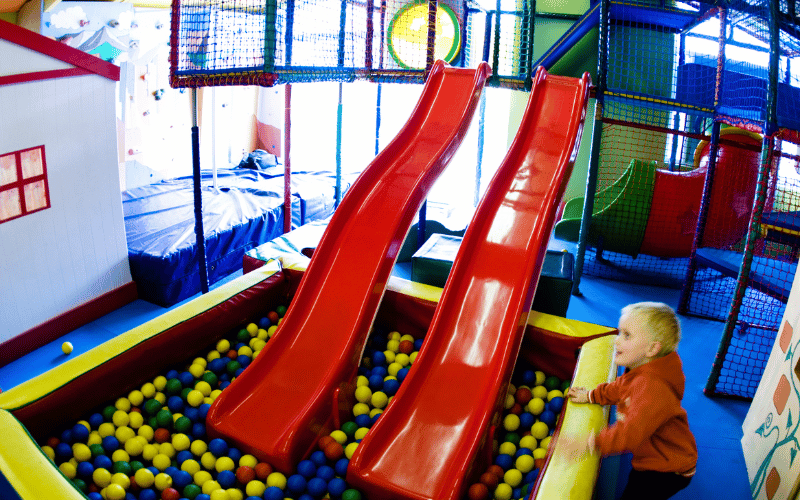Indoor play spaces are in high demand as parents seek safe, engaging environments for their children to explore and grow. Now is the perfect time to capitalize on this trend and create a thriving business. This guide offers actionable steps, insider tips, and proven strategies to help you design, launch, and manage a successful indoor play space that stands out in today’s competitive market.
Table of Contents
ToggleI. Planning Your Indoor Playground: The Blueprint for Success
Building an indoor playground is like crafting a masterpiece—it requires vision, precision, and a deep understanding of the canvas you’re working with. With decades of experience in the outdoor play equipment industry, I’ve seen what works and what doesn’t. Let me guide you through the essential steps to ensure your indoor playground becomes a thriving hub of joy and safety.
Understanding Your Market
Your market is the heartbeat of your business, and understanding it is non-negotiable. Start by identifying your target demographics. Are you catering to toddlers, preschoolers, or school-age children? Each age group has unique needs, from the size and type of equipment to the level of supervision required. For example, toddlers thrive in low-height, sensory-rich environments, while older kids crave climbing walls and obstacle courses that challenge their growing skills.
Next, study your local competition. Visit other indoor play spaces in your area and take notes—what are they doing well, and where are the gaps? If their equipment whispers “fun,” yours should shout “unforgettable.” Look for ways to differentiate, whether it’s through unique play structures, themed environments, or added amenities like a café for parents. Your goal is to create a space that not only meets but exceeds the expectations of your community.
Crafting a Business Plan
Think of your business plan as the blueprint for your playground—it’s the foundation that holds everything together. Start with a clear mission and vision. Why are you building this space, and what do you hope to achieve? For instance, your mission might be to create a safe and inclusive environment where children can develop their physical and social skills through play.
Financial projections are your compass. Outline your startup costs, including equipment, rent, and marketing, and estimate your revenue streams. Will you rely on admission fees, memberships, or event bookings? Be realistic but ambitious—your projections should inspire confidence in potential investors or lenders.
Operational strategies are the nuts and bolts of your plan. Detail how you’ll manage day-to-day activities, from staffing and maintenance to customer service. For example, consider implementing a reservation system to manage peak hours and ensure a smooth experience for families. A well-thought-out business plan doesn’t just guide you—it convinces others to believe in your vision.

Navigating Legal and Safety Requirements
Legal and safety requirements are the guardians of your playground, ensuring it remains a haven for children and a worry-free zone for parents. Here’s a concise checklist to keep you on track:
- Permits and Zoning: Verify that your chosen location complies with local zoning laws and obtain all necessary permits. Consult with your city’s planning department to avoid surprises.
- Insurance: Secure comprehensive liability insurance that covers injuries, property damage, and other potential risks. Think of it as your safety net for the unexpected.
- Health Regulations: Ensure your facility meets health standards, including proper ventilation, sanitation, and restroom facilities. Regular cleaning schedules should be non-negotiable.
- Safety Standards: Adhere to ASTM and CPSC guidelines for indoor play equipment. For example, ensure all surfaces are padded, and equipment is free of sharp edges or entrapment hazards.
- Emergency Preparedness: Develop a plan for emergencies, including first-aid kits, fire exits, and staff training. Your team should be as prepared as a lifeguard at a busy pool.
By addressing these legal and safety requirements with diligence, you’re not just protecting your business—you’re building trust with your community.
With these steps, you’re well on your way to creating an indoor playground that’s not just a business but a beloved destination. Let your expertise and passion shine through every decision, and watch as your vision transforms into a vibrant, thriving reality.
II. Designing an Engaging and Safe Indoor Playground
Designing an indoor playground is like orchestrating a symphony—every element must work in harmony to create an experience that’s both captivating and secure. Let’s dive into the key components that will make your playground a standout destination for families.
Location Matters
Your location is the stage where your playground’s story unfolds, and it needs to set the right tone. Choose a space that’s highly visible and easy to access. Think about proximity to schools, daycare centers, and family-friendly neighborhoods. A location near complementary businesses, like coffee shops or family restaurants, can also drive foot traffic.
Parking is a non-negotiable feature. Families need ample, safe parking spaces, ideally with stroller-friendly access. If your location is in a mall or shared complex, ensure clear signage guides visitors to your entrance. Picture your playground as a beacon of fun—make it easy for families to find and enter.
Creating a Unique Play Experience
A playground should feel like stepping into a new world, one that sparks imagination and invites exploration. Start by choosing a theme that resonates with your audience. Whether it’s a jungle adventure, outer space, or a whimsical fairytale, let the theme guide your equipment choices, color palette, and decor.
Age-appropriate equipment is the backbone of a successful play space. For toddlers, include soft play areas with low climbing structures and sensory panels. Preschoolers will love slides, tunnels, and interactive play panels, while older kids crave challenges like rope courses, climbing walls, and obstacle courses. Each piece of equipment should feel like a character in your playground’s story, contributing to the overall experience.
Maximizing play value means creating opportunities for physical, social, and cognitive development. Incorporate elements that encourage group play, like multi-user slides or collaborative games. Add quiet zones with puzzles or books for kids who need a break from the action. A well-rounded playground caters to every child’s needs, ensuring no one feels left out.

Safety First
Safety isn’t just a feature—it’s the foundation of your playground. Start with high-quality materials that meet or exceed safety standards. Opt for non-toxic, durable finishes and soft, impact-absorbing surfaces like rubber flooring or foam mats. These materials act as silent guardians, cushioning falls and preventing injuries.
Partnering with reputable suppliers is crucial. Look for manufacturers who provide certifications for their equipment, such as compliance with ASTM or EN standards. A good supplier will also offer installation services and ongoing support, ensuring your playground remains safe and functional over time.
Regular maintenance is your playground’s insurance policy. Schedule routine inspections to check for wear and tear, loose bolts, or damaged surfaces. Address issues immediately—your playground should always feel as safe as a parent’s embrace.
Incorporating Technology
Technology can elevate your playground from fun to unforgettable. Interactive elements like projection play systems or digital games add a modern twist to traditional play. Imagine a floor that transforms into a soccer field or an underwater world with a simple touch—these features captivate kids and keep them coming back.
Balance is key. Technology should enhance, not replace, physical play. Use it to complement climbing structures, slides, and other equipment. For example, a digital climbing wall can challenge kids to reach glowing targets, combining physical activity with interactive fun.
When integrating technology, choose systems that are easy to maintain and update. Work with providers who offer training and support, so your staff can troubleshoot issues quickly. Technology should feel like a seamless part of your playground, not a complicated add-on.
By focusing on location, play experience, safety, and technology, you’ll create an indoor playground that’s as engaging as it is secure. Every decision you make should reflect your commitment to providing a space where children can play, learn, and grow with joy and confidence.
III. Running a Smooth Operation: Day-to-Day Excellence
An indoor playground is like a finely tuned machine—every part must work seamlessly to deliver a safe, enjoyable experience for families while keeping your business running efficiently. Let’s break down the key elements that will ensure your operation hums along smoothly.
Building a Stellar Team
Your staff are the face of your playground, and their performance can make or break the customer experience. Start by hiring individuals who genuinely enjoy working with children and families. Look for candidates with backgrounds in childcare, education, or hospitality, as they often bring the right mix of patience, energy, and professionalism.
Training is where your team transforms from good to exceptional. Begin with safety protocols—every staff member should know how to handle first aid, respond to emergencies, and enforce playground rules without being overbearing. Role-play scenarios like assisting a child who’s fallen or addressing a parent’s concern to build confidence and consistency.
Customer service training is equally critical. Teach your team to greet families warmly, resolve issues quickly, and maintain a positive attitude even during busy hours. Empower them to go the extra mile, whether it’s helping a parent carry a stroller or offering a bandage for a scraped knee. Your staff should feel like the playground’s ambassadors, ensuring every visitor leaves with a smile.
Pricing and Revenue Strategies
Your pricing structure should reflect the value you’re offering while remaining accessible to your target audience. Start with a competitive analysis—what are similar facilities charging in your area? Use this as a baseline, then adjust based on your unique features and services.
Memberships are a great way to build loyalty and ensure steady revenue. Offer tiered options, such as monthly or annual plans, with perks like discounted party packages or early access to special events. For example, a “Gold Membership” could include unlimited playtime and a free guest pass each month, making it an attractive option for frequent visitors.
Party packages are another lucrative revenue stream. Create all-inclusive options that include playtime, decorations, food, and a dedicated host. Offer add-ons like themed decor or goody bags to increase the average spend. Position your playground as the go-to destination for birthdays and celebrations by making the process seamless for parents.
Don’t overlook additional revenue opportunities like concessions or retail. A small café with coffee, snacks, and kid-friendly meals can keep families on-site longer, while a retail corner with toys, branded merchandise, or even socks (a common forgotten item) can boost your bottom line. Think of these extras as the playground’s sidekicks, enhancing the overall experience while driving profit.

Streamlining Operations
Efficiency is the unsung hero of a well-run playground. Start with a robust booking system that allows parents to reserve play sessions, parties, or memberships online. Look for platforms that integrate with payment processing and send automated reminders to reduce no-shows. A user-friendly system saves time for both your staff and your customers.
Payment platforms should be versatile and secure. Offer multiple options, including credit cards, mobile payments, and even contactless methods, to accommodate all preferences. A smooth checkout process leaves a lasting impression and encourages repeat visits.
Maintenance schedules are the backbone of safety and reliability. Create a detailed checklist for daily, weekly, and monthly tasks, from sanitizing equipment to inspecting for wear and tear. Assign specific responsibilities to staff members and use a digital tracking system to ensure nothing gets overlooked. For example, designate one team member to check surfacing and another to test equipment stability each morning. Regular maintenance isn’t just about preventing issues—it’s about showing families you care.
By building a strong team, implementing smart pricing strategies, and streamlining your operations, you’ll create a playground that runs like clockwork. Every detail, from the way your staff greets visitors to the ease of booking a party, contributes to an experience that families will want to return to again and again.
IV. Growing Your Business: Marketing and Scaling
Growing an indoor playground business is like nurturing a sapling into a towering tree—it requires care, strategy, and the right tools to thrive. Let’s explore how to build a strong foundation for your brand, attract loyal customers, and scale your operations with precision.
Building Your Brand
Your brand is the personality of your playground, and it should resonate with families from the moment they hear your name. Start by crafting a name that’s memorable, playful, and reflective of your mission. Avoid generic terms—your name should evoke excitement and curiosity. For example, “Adventure Haven” or “Little Explorers’ Kingdom” paints a vivid picture of what families can expect.
Your logo is your visual handshake. Choose colors and fonts that align with your target audience—bright, cheerful tones for younger children or a more modern, sleek design if you’re catering to older kids and parents. Work with a professional designer to ensure your logo is versatile enough for signage, merchandise, and digital platforms.
Your brand message should be the heartbeat of your marketing efforts. What makes your playground unique? Perhaps it’s your focus on imaginative play, your commitment to safety, or your inclusive environment. Craft a tagline that encapsulates this, like “Where Play Meets Possibility” or “Safe Adventures, Big Smiles.” Every piece of communication should echo this message, creating a consistent and compelling identity.

Digital Marketing Mastery
In today’s world, your online presence is as important as your physical space. Start with a website that’s easy to navigate, mobile-friendly, and optimized for search engines. Include high-quality photos, a clear list of services, and an online booking system. Use keywords like “indoor playground near me” or “kids’ birthday party venue” to improve your local SEO and attract nearby families.
Social media is your playground for engagement. Post regularly on platforms like Instagram and Facebook, sharing behind-the-scenes looks, customer testimonials, and upcoming events. Use stories and reels to showcase the energy and joy of your space—parents love seeing happy kids in action. Encourage user-generated content by creating a branded hashtag and offering small incentives for families who share their experiences online.
Email campaigns are your secret weapon for retention. Build a mailing list through your website or in-person sign-ups, and send regular updates about promotions, events, or new features. Personalize your emails with the recipient’s name and tailor content to their interests—parents who’ve booked a party might appreciate tips for planning or exclusive discounts on future bookings.
Local Outreach
Your community is your strongest ally, so make connections that count. Partner with local schools, daycare centers, and parent groups to spread the word about your playground. Offer exclusive discounts or host field trips to introduce your space to new families.
Community events are a powerful way to build goodwill and attract visitors. Host a “Family Fun Day” with free play sessions, face painting, and giveaways, or sponsor local events like school fairs or charity runs. These efforts position your playground as a cornerstone of the community, fostering trust and loyalty.
Don’t forget to leverage local SEO. Claim your Google My Business listing and ensure your address, hours, and contact information are accurate. Encourage satisfied customers to leave reviews—positive feedback not only boosts your ranking but also builds credibility with potential visitors.
Measuring Success
Growth without measurement is like driving without a map—you need to know where you’re going and how to get there. Track key performance indicators (KPIs) like monthly revenue, customer retention rates, and online engagement. For example, if your social media posts aren’t driving traffic, it might be time to adjust your content strategy.
Gather feedback directly from your customers. Use surveys, comment cards, or casual conversations to learn what families love and what they’d like to see improved. If parents consistently mention a lack of seating or limited snack options, address these issues promptly. Listening to your customers isn’t just good business—it’s the key to staying relevant and competitive.
Scaling Smartly
Scaling your business is an exciting milestone, but it requires careful planning. Before expanding, ensure your current location is running smoothly and consistently meeting customer expectations. A strong foundation makes growth sustainable.
If you’re considering new services, start small. For example, add a seasonal offering like summer camps or parent-and-child classes to test demand. Monitor the response and refine your approach before committing to a larger rollout.
When opening a new location, choose an area with similar demographics to your first site. Use the lessons you’ve learned to replicate your success while tailoring the new space to its unique community. Think of each location as a sibling—similar in values but with its own personality.
By building a strong brand, mastering digital marketing, engaging with your community, and scaling thoughtfully, you’ll create a business that not only grows but thrives. Every step you take should reflect your commitment to creating a space where families feel welcome, valued, and eager to return.
Conclusion
Building a profitable indoor playground begins with understanding your market, creating a robust business plan, and designing a space that strikes a balance between safety and engagement. Success grows through effective marketing, community connections, and streamlined operations. Take the first step today—start drafting your business plan, researching potential locations, and outlining your unique vision. Every great business begins with action, so turn your ideas into reality and create a space where families can play, connect, and thrive.
FAQs
Q: How much does it cost to open an indoor playground?
A: Opening an indoor playground typically costs between $100,000 and $500,000, depending on factors like location, size, and equipment. Major expenses include leasing or purchasing a space, installing play structures, and meeting safety standards—budget for additional costs like insurance, marketing, and staff training. Start with a detailed financial plan to estimate your specific needs and secure funding.
Q: What permits are needed for an indoor playground?
A: You’ll need permits for zoning, building, and fire safety to open an indoor playground. Check local zoning laws to ensure your chosen location allows for commercial recreational use. Obtain building permits for renovations and ensure fire safety compliance with proper exits, sprinklers, and occupancy limits. Health permits may also be required if you plan to serve food. Contact your local government to confirm all necessary licenses.
Q: How can I make my indoor playground stand out from competitors?
A: Focus on creating a unique experience that families can’t find elsewhere. Choose a memorable theme, like a jungle or space adventure, and design age-appropriate play areas. Offer additional services like birthday party packages, parent-friendly amenities, or interactive technology like projection games. Build strong community ties by hosting events and partnering with local schools or organizations. Consistently deliver excellent customer service to keep families coming back.
Q: What are important safety considerations for an indoor playground?
A: Safety starts with high-quality, certified equipment and impact-absorbing flooring. Regularly inspect and maintain play structures to prevent wear and tear. Train staff to handle first aid and enforce safety rules, like age-appropriate play and proper use of equipment. Ensure your facility meets fire and health codes, and keep a well-stocked first-aid kit on-site. Clear signage and supervision help create a safe environment for everyone.
Q: How can an indoor playground generate consistent revenue?
A: Diversify your revenue streams to maintain steady income. Offer memberships for unlimited play, host birthday parties with customizable packages, and sell concessions or retail items like toys and socks. Introduce seasonal programs like summer camps or parent-and-child classes to attract new customers. Use promotions, loyalty programs, and email campaigns to encourage repeat visits and build a loyal customer base.






